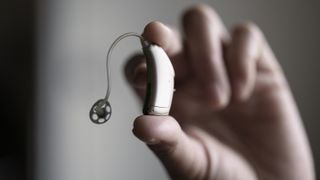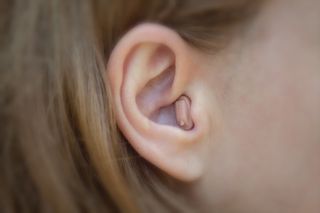Hearing aids: How they work and which type is best for you

Hearing aids are small electronic devices that a person wears in or behind their ears. These devices amplify ambient sound and allow people with mild to severe hearing loss to hear the sounds around them. They do not restore a person's hearing, but rather increase the volume of environmental sounds.
Olive Pro: 2-in-1 Hearing Aids & Bluetooth Earbuds | $199 and up at Olive Union
The Olive Pro is a combination hearing aid and bluetooth earbud that the company says will lead to much better hearing and conversational understanding due to the automated background noise cancellation and crisp sound quality. The Olive Pro is currently on pre-order.
How do hearing aids work?
Most modern hearing aids are digital. Digital hearing aids consist of three parts, according to Johns Hopkins:
—a microphone, to pick up sound waves and convert them into a digital signal;
—an amplifier, to make specific sound frequencies louder;
—a speaker, to convert the digital signal back into sound waves and transmit the louder sound down a person's ear canal.
Who benefits from hearing aids?
The World Health Organization estimates that 1.5 billion people worldwide have some degree of hearing loss, and that this number will rise to 2.5 billion by 2050.
There are three primary types of hearing loss, depending on which part of the ear is damaged, according to the American Speech-Language-Hearing Association. The first is conductive hearing loss, in which sound waves cannot reach the inner ear due to fluid, infection, objects or physical damage blocking the ear canal. Sensorineural hearing loss, the second type, occurs when the inner ear itself is hurt by overly loud sounds, drugs, aging, illness or nerve damage. Mixed hearing loss, which is a mixture of the two, is the third type.
Hearing aids are best suited to assist people who have sustained damage to the small sensory cells in their inner ear, called hair cells, said the U.S. National Institute on Deafness and Other Communication Disorders (NIDCD). This is a form of sensorineural hearing loss caused by disease, aging, noise-related injury or certain medicines.
"A hearing aid magnifies sound vibrations entering the ear," said the NIDCD. "Surviving hair cells detect the larger vibrations and convert them into neural signals that are passed along to the brain. The greater the damage to a person's hair cells, the more severe the hearing loss and the greater the hearing aid amplification needed to make up the difference." However, there are limits to how much a hearing aid can magnify sounds, and the hair cells can be too damaged to pick up sounds, no matter how loud they are.
Different types of hearing aids
Behind-the-ear (BTE) hearing aid
This aid hooks onto a person's ear. It consists of a hard plastic case, which sits behind the ear, connected to a small plastic, resin, acrylic or silicone earmold, which sits inside the outer ear. According to the U.K. National Health Service, it is the most common type of hearing aid. The behind-the-ear case contains the device's electronics, and sound travels from the hearing aid, via the earmold, into the ear.

Pros of BTE hearing aids:
—A wide variety of people can use these aids, from young children to older adults, and they can assist with a broad spectrum of hearing loss, according to Hearing Aid UK, Ltd.
—They have larger batteries and so last longer.
—These aids tend to be cheaper than other models and are available in many styles and colors, with many functions.
Cons of BTE hearing aids:
—Behind-the-ear hearing aids are not as discrete as other models, such as in-the-canal aids.
—The earmold can get blocked with ear wax and requires cleaning to avoid damage.
—These aids can make phone use awkward, because you have to hold your phone to the microphone rather than your ear canal.
Newer versions of this type of aid, called mini-BTE, have a smaller earmold, so that it does not block the outer ear completely. The smaller earmold means that fluid can drain in the ear.
In-the-ear (ITE) hearing aid
In-the-ear hearing aids sit entirely inside the outer ear. A hard plastic case still contains all the device's electronic components. There are two designs for this type of hearing aid: They can fill the ear bowl completely (called full shell) or partially (called half shell), depending on the wearer's preference.

Pros of ITE hearing aids:
—These aids are discrete, comfortable and small, according to Hearing Aid UK, Ltd.
—They are easy to insert into the ear
—Because they are in the ear, they are shielded from wind noise
Cons of ITE hearing aids:
In-the-canal (ITC) and completely-in-the-canal (CIC) hearing aids
In-the-canal hearing aids are custom molded to a person's ear canal. Some of them are almost invisible, being completely contained within the ear canal, while others are partially visible. Additionally, they have smaller batteries and less computing circuitry space (because they have to be as small as possible). Practically, this means that they cannot amplify as loudly and lack some of the signal processing functions that other types have.

Pros of ITC hearing aids:
—Partially or completely invisible, depending on whether ITC or CIC, according to the AARP.
—Easy to use a phone with these aids
Cons of ITC hearing aids:
—Because of their small size, they can be fiddly to insert and some can only be inserted by a professional.
—They tend to be expensive.
—They are small and so lack the battery and computing power of other types of hearing aids, and so may not be suitable for severe hearing loss.
How do smart hearing aids work?
In the same way that hearing aids benefited from the invention of the transmitter and transistor, they are also enjoying the current technological push in computer processing and big data. "Artificial intelligence has revolutionized the hearing aid industry and has brought a wide array of capabilities to the technology that helps you hear," said Hearing Industries Association, an American hearing aid lobby group.
For example, next-generation hearing aids, sometimes referred to as "smart" hearing aids, are able to connect to other internet-capable devices and remember a wearer's preferences. They can detect the wearer's environment and learn which noises to mute, like the clank of plates and background voices in a restaurant, and which to emphasize, such as the voice of another person sitting at the same table. By linking hearing aids to smartphones, apps are now also able to "clean" the sounds that the aid-wearer hears, making it easier to cut out noise, Healthy Hearing reported.
According to one article on a "smart" hearing aid from WIRED, linking to the internet and GPS allows the hearing aid to remember settings for different locations and automatically adjust its own levels. These levels could even be transmitted to a cloud-based service, said an article from the Institution of Engineering and Technology, with pre-set levels for different environments.
Current hearing aids are already able to stream music and audiobooks.
How do I know if I need a hearing aid?
According to the Mayo Clinic, signs of hearing loss include:
—Muffled speech and sound
—Struggling to understand works, especially when there is noise in the background
—You find yourself constantly asking people to speak more loudly or to repeat themselves
—Difficult hearing consonants
—Playing the TV or music at a volume that other people find too loud
—Withdrawing from conversations because you struggle to understand what people are saying
If you suspect that you may be losing your hearing, which happens naturally with age, or if you have a sudden loss of hearing in one or both ears, see a doctor. Hearing tests are also available online.
How do I get a hearing aid?
To rule out other causes of your hearing loss — such as an infection, ear wax, infection or rarely a tumor — the FDA recommends people get a medical examination by either a general practitioner or, preferrably, an ear, nose and throat doctor. The FDA strongly recommends a medical examination for anyone under age 18: "For hearing aid consumers younger than 18 years of age, the FDA will continue to enforce the medical evaluation requirement to rule out medical causes of hearing loss prior to buying hearing aids," the FDA said in a statement.
However, if you are 18 years or older and don't think you need a medical evaluation, a hearing test is a must. Several companies also offer hearing tests online. In addition, a general doctor will be able to refer you to an audiologist, which is a hearing specialist, who will perform a hearing test. This test measures how loud a sound needs to be for you to hear it and how clear it is, according to Harvard Medical School. "People with normal hearing can hear sounds less than 25 decibels (dB). If the softest sounds you can hear are 30 dB or louder, you may be missing a significant amount of what is said to you and are probably a candidate for a hearing aid."
The audiologist will be able to guide you in which hearing aid would suit you best.
History of hearing aids

Even before the advent of modern electronics, people who were partially deaf or hard of hearing used tools to amplify sounds. The simplest tool, the ear trumpet or horn, was a funnel-shaped implement that people inserted into their ears to improve their ability to hear. The large mouth of the funnel collected sound waves from the environment and channelled them into a person's ear.
French Jesuit priest and mathematician Jean Leurechon was the first person to describe the ear trumpet in 1634 in his work "Recreations Mathématiques," wrote Max Valentinuzzi, a professor emeritus with the Universidad Nacional de Tucumán in Argentina, in a paper published in journal IEEE. By the end of the 1700s, ear trumpets were commonplace, according to Valentinuzzi.
But the invention of the telephone presaged the hearing aid revolution, Valentinuzzi continued. In 1870, Thomas Edison developed the carbon transmitter for his telephone, which amplified electric signals and increased the resulting sound's volume.
In 1898, American electrical engineer Miller Reese Hutchison used a carbon transmitter to build a portable amplifier. His invention –– "the akouphone" –– was the first dedicated electric hearing aid.
By 1920, said the Kent State University Hearing Aid Museum, hearing aid makers were experimenting with vacuum tubes instead of carbon transmitters as they were able to achieve a greater amplification. However, they were bulky and unwieldy.
The era of small, discreet hearing aids began in 1948 when Bell Telephone Laboratories invented the transistor, Valentinuzzi wrote. The transistor, which is at the heart of modern electronics, allowed hearing aids to control the flow of electrical current and its subsequent volume. They were also much smaller than previous models, and a person could wear the device in their ear.
In fact, after World War II, hearing aids became a test ground for the miniaturization of electronics. Their users became the first consumer market for printed circuits, transistors, and integrated circuits, wrote Mara Mills, an associate professor of media, communication, and culture at New York University.
"The new hearing aids were so popular and successful that more than 200,000 transistor hearing aids were sold in 1953 alone, eclipsing the sale of vacuum tube models," Max Valentinuzzi wrote in his article.
The circuitry in today's hearing aids is much more sophisticated, Mills wrote in her article, and able to amplify certain frequencies while cutting out others that might be part of background noise.
Additional resources:
—Here are the signs that you may need a hearing aid.
—With a piece of paper, you can make your own ear trumpet.
—Watch this video to see how your ear works.
Sign up for the Live Science daily newsletter now
Get the world’s most fascinating discoveries delivered straight to your inbox.
Sarah Wild is a science journalist and a regular contributor to Live Science and Space.com. She is the author of "Searching African Skies: The Square Kilometre Array", "Innovation: Shaping South Africa through Science" and "South Africa's Quest to Hear the Songs of the Stars." Wild was the winner of the Siemens pan-African Profile Awards for science journalism in 2013 and received the Dow Technology and Innovation Reporting award in 2015.

